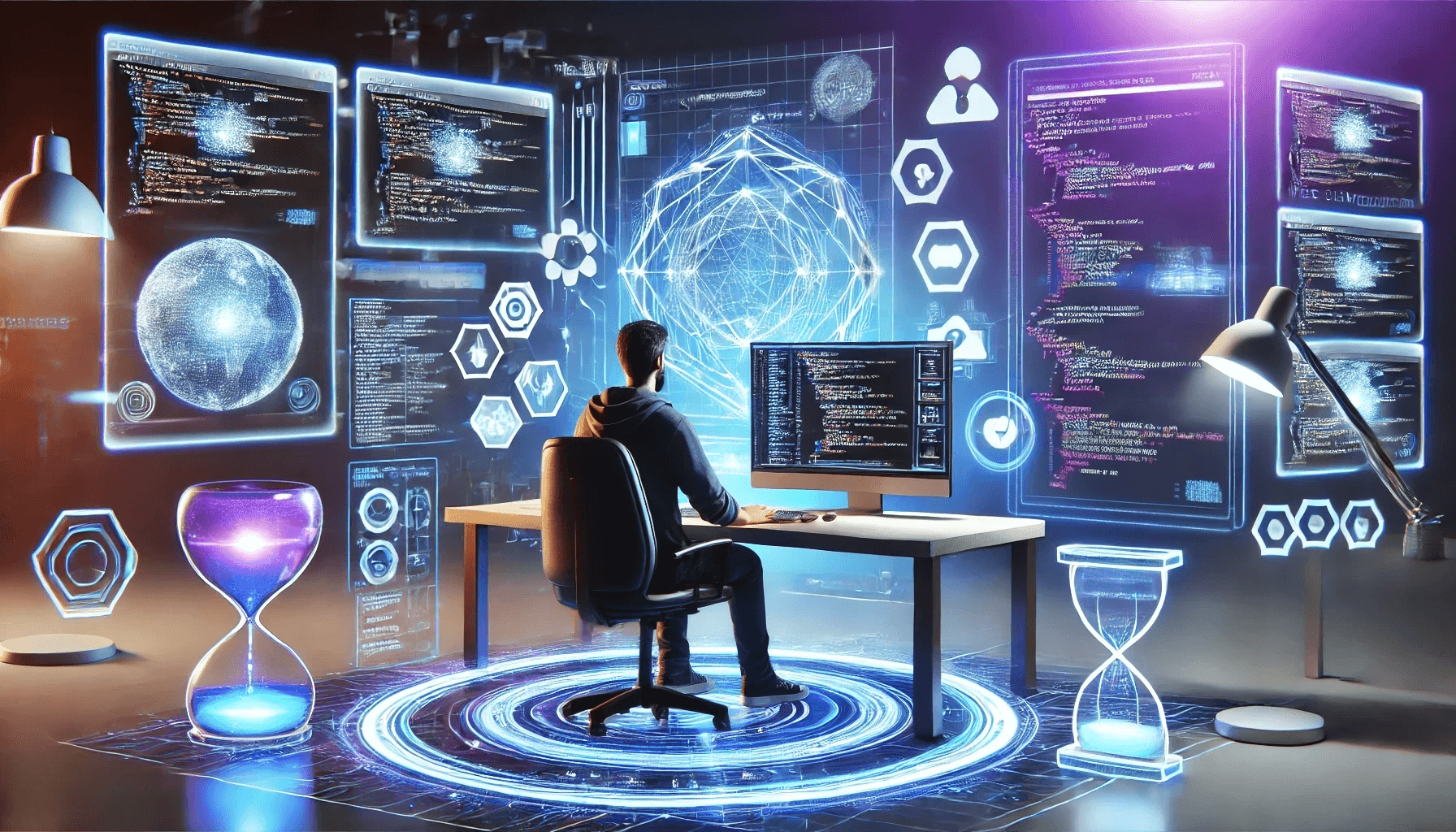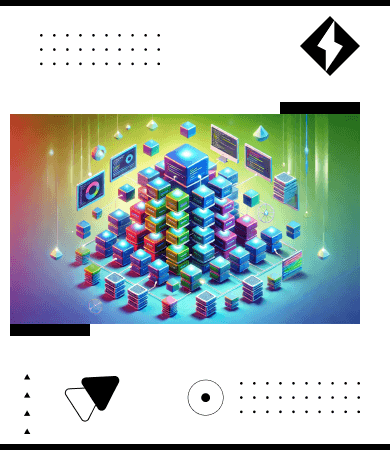Support center +91 97257 89197
Web DevelopmentJuly 2, 2024
Future Trends in Generative AI for Web Developers

Introduction
Generative AI, a subset of artificial intelligence focused on creating new content from existing data, is rapidly transforming the landscape of web development. This technology enables machines to generate text, images, code, and more, streamlining the development process and enhancing creativity. As the web development field evolves, understanding the future trends in generative AI becomes crucial for developers aiming to stay competitive and innovative.
Generative AI in Web Development: Current State
Generative AI is already making significant inroads in web development, with numerous tools and frameworks available to assist developers. Some popular examples include:
- GitHub Copilot: An AI-powered code completion tool that provides code suggestions as developers type, helping them write code faster and with fewer errors.
- Adobe XD: A design tool that uses AI to suggest design elements and layouts, making the design process more efficient.
- Grammarly: An AI-driven tool for content optimization that helps improve writing quality and SEO performance.
These tools are just the beginning, as generative AI continues to advance and integrate more deeply into web development workflows.
Enhanced Code Generation
One of the most exciting applications of generative AI in web development is enhanced code generation. AI-assisted coding tools like GitHub Copilot and Tabnine are transforming how developers write and optimize code. Here are some key features:
- AI-Assisted Coding: Tools like GitHub Copilot can predict and complete code snippets, significantly speeding up the development process. These tools learn from vast codebases and can provide context-aware suggestions, reducing the cognitive load on developers.
- Automated Code Refactoring and Optimization: Generative AI can analyze existing code and suggest improvements, such as optimizing performance, enhancing readability, and reducing redundancy. This ensures that codebases remain maintainable and efficient over time.
- Predictive Text for Coding: Similar to predictive text in messaging apps, AI can suggest entire lines or blocks of code based on the developer's current input. This feature helps developers avoid common errors and adhere to best practices.
Design and UX Enhancements
Generative AI is also revolutionizing web design and user experience (UX) by providing tools and techniques that enhance creativity and efficiency. Key advancements include:
- AI-Driven Design Tools: Platforms like Adobe XD and Figma are incorporating AI to suggest design elements, layouts, and color schemes. These tools can analyze existing designs and recommend improvements, helping designers create visually appealing and user-friendly interfaces.
- Personalized User Experiences: AI can analyze user behavior and preferences to create personalized experiences. For instance, AI-driven recommendations can tailor content and features to individual users, improving engagement and satisfaction.
- AI in UX Research and Usability Testing: AI tools can conduct automated usability testing, identifying issues and suggesting improvements. This accelerates the UX research process and ensures that designs are user-centric and effective.
Content Creation and Management
Generative AI is transforming content creation and management, making it easier for web developers and content creators to produce high-quality, engaging content. Here are some notable trends:
- Automated Content Generation: AI tools like GPT-4 can generate articles, blog posts, product descriptions, and more. This capability saves time and ensures a consistent flow of content, which is essential for maintaining an active online presence.
- AI for SEO Optimization: AI can analyze search trends and optimize content for search engines. Tools like Clearscope and MarketMuse provide keyword suggestions and content recommendations to improve search engine rankings.
- Dynamic Content Personalization: AI can personalize content based on user behavior and preferences. This includes tailored recommendations, personalized marketing messages, and adaptive content that changes based on user interactions.
Testing and Debugging
Testing and debugging are critical aspects of web development, and generative AI is playing a pivotal role in enhancing these processes. Here’s how:
- AI in Automated Testing: AI-driven testing tools can create and execute test cases, identify bugs, and suggest fixes. This reduces the time and effort required for manual testing and ensures that applications are thoroughly tested before deployment.
- Error Prediction and Debugging: AI can predict potential errors and provide real-time debugging suggestions. Tools like DeepCode analyze codebases to identify vulnerabilities and recommend fixes, improving code quality and security.
- Performance Optimization Using AI: AI can monitor application performance and suggest optimizations. This includes identifying slow-performing code, recommending efficient algorithms, and optimizing resource usage.
AI-Powered APIs and Integrations
The integration of AI-powered APIs is another trend shaping the future of web development. These APIs enable developers to add advanced functionalities to their applications without building complex AI models from scratch. Examples include:
- Natural Language Processing (NLP) APIs: These APIs, such as Google Cloud's NLP and OpenAI's GPT, allow applications to understand and generate human language. This is useful for chatbots, content generation, and sentiment analysis.
- Computer Vision APIs: APIs like Amazon Rekognition and Google Vision enable image and video analysis, providing functionalities like object detection, facial recognition, and image classification.
- Recommendation System APIs: These APIs use AI to analyze user behavior and preferences, offering personalized recommendations for products, content, and services.
Security and Privacy Considerations
As AI becomes more integrated into web development, security and privacy considerations are paramount. AI can both enhance and challenge security and privacy efforts:
- AI in Threat Detection and Prevention: AI-driven security tools can analyze patterns and detect anomalies, identifying potential threats in real-time. This proactive approach helps prevent attacks and secure applications.
- Ensuring Data Privacy with AI Solutions: AI can help enforce data privacy regulations by identifying and managing sensitive information. Tools can automate compliance tasks, ensuring that applications adhere to privacy standards like GDPR and CCPA.
- Ethical Considerations and Responsible AI Use: As AI systems become more powerful, ethical considerations such as bias, transparency, and accountability are crucial. Developers must ensure that AI is used responsibly, with clear guidelines and oversight to prevent misuse.
Future Predictions
The future of generative AI in web development holds exciting possibilities. Here are some predictions for how this technology will continue to evolve:
- Evolution of AI in Web Development: AI will become more intuitive and capable, enabling even more sophisticated code generation, design suggestions, and content creation. This will further streamline the development process and enhance creativity.
- Emerging Trends and Technologies: New technologies such as quantum computing and advanced neural networks will push the boundaries of what AI can achieve. This will lead to more powerful tools and frameworks for web developers.
- Long-Term Impact on the Web Development Industry: Generative AI will fundamentally change the web development industry, making it more efficient and innovative. Developers will need to continually adapt and learn to leverage AI effectively, ensuring they remain at the forefront of technological advancements.
Conclusion
Generative AI is revolutionizing web development by enhancing code generation, design, content creation, and security. As these technologies evolve, web developers must stay informed and adaptable to leverage AI's full potential. Embracing generative AI will not only streamline workflows but also unlock new levels of creativity and innovation in web development.
TLDR
Generative AI is revolutionizing web development by enhancing code generation, design, content creation, and security. This article explores the current applications, future predictions, and how web developers can leverage these advancements to stay competitive.
FAQs
Generative AI refers to algorithms that can create new content, such as text, images, and code, by learning from existing data. It is widely used in various applications, including web development, to enhance productivity and creativity.
AI can assist in web development through code generation, design suggestions, automated content creation, and testing. It helps developers write cleaner code, create better user experiences, and ensure the robustness of web applications.
Current tools include GitHub Copilot for code suggestions, Adobe XD for AI-driven design, and Grammarly for content optimization. These tools streamline the development process and enhance productivity.
AI can significantly enhance security by detecting vulnerabilities and predicting potential threats. However, it also introduces challenges related to data privacy and ethical use, which need to be carefully managed.
Future trends include more advanced AI-assisted coding tools, deeper integration of AI in user experience design, enhanced automated testing and debugging, and increased use of AI for personalized content and security solutions.
Work with us







